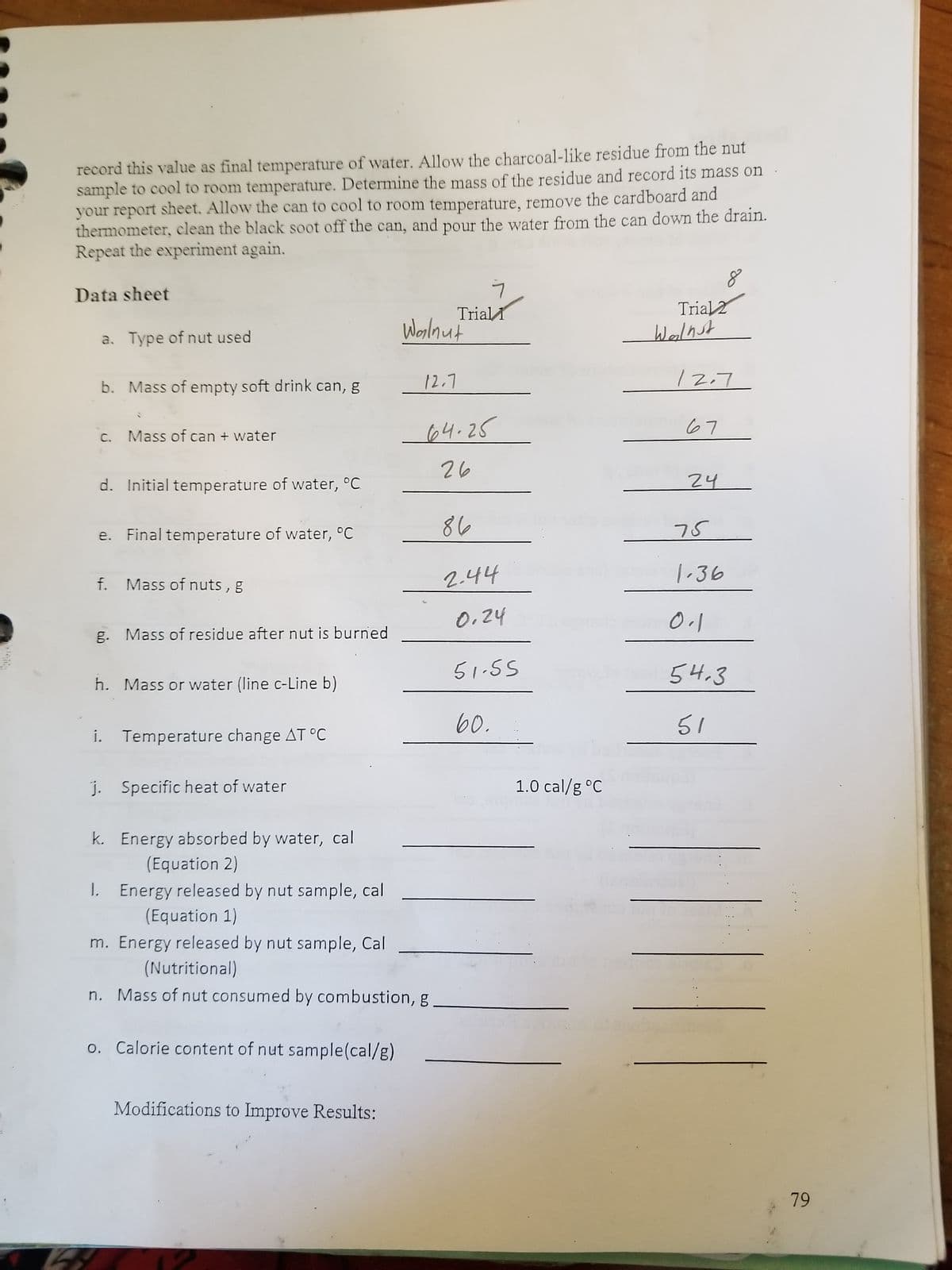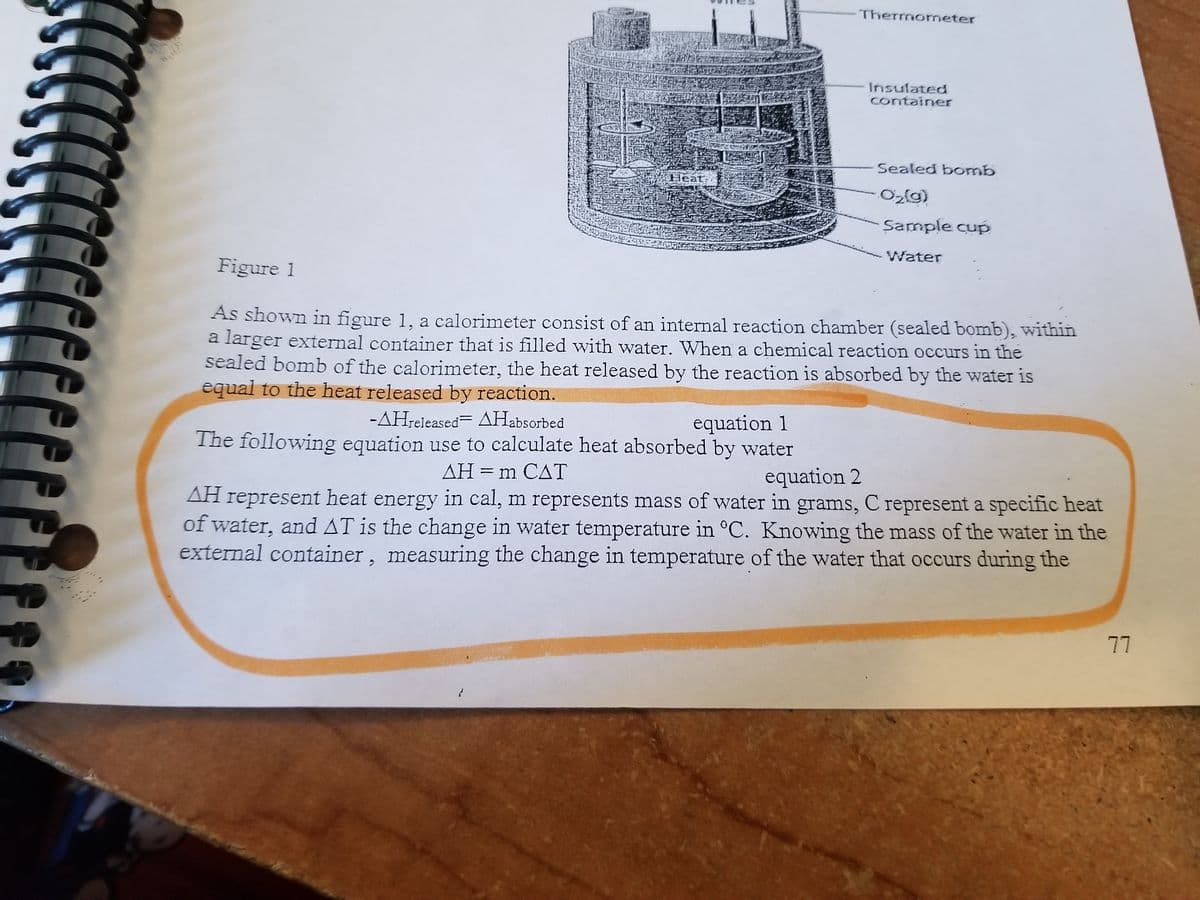record this value as final temperature of water. Allow the charcoal-like residue from the nut sample to cool to room temperature. Determine the mass of the residue and record its mass on your report sheet. Allow the can to cool to room temperature, remove the cardboard and thermometer, clean the black soot off the can, and pour the water from the can down the drain. Repeat the experiment again. Data sheet a. Type of nut used b. Mass of empty soft drink can, g C. 3 Mass of can + water d. Initial temperature of water, °C e. Final temperature of water, °C f. Mass of nuts, g g. Mass of residue after nut is burned h. Mass or water (line c-Line b) i. Temperature change AT °C j. Specific heat of water k. Energy absorbed by water, cal (Equation 2) o. Calorie content of nut sample(cal/g) Modifications to Improve Results: Trial Walnut 1. Energy released by nut sample, cal (Equation 1) m. Energy released by nut sample, Cal (Nutritional) n. Mass of nut consumed by combustion, g. 12.7 64.25 26 86 2.44 0.24 51-55 60. 1.0 cal/g °C Trial2 Walnut 12.7 67 24 75 1.36 0.1 54.3 51 79
record this value as final temperature of water. Allow the charcoal-like residue from the nut sample to cool to room temperature. Determine the mass of the residue and record its mass on your report sheet. Allow the can to cool to room temperature, remove the cardboard and thermometer, clean the black soot off the can, and pour the water from the can down the drain. Repeat the experiment again. Data sheet a. Type of nut used b. Mass of empty soft drink can, g C. 3 Mass of can + water d. Initial temperature of water, °C e. Final temperature of water, °C f. Mass of nuts, g g. Mass of residue after nut is burned h. Mass or water (line c-Line b) i. Temperature change AT °C j. Specific heat of water k. Energy absorbed by water, cal (Equation 2) o. Calorie content of nut sample(cal/g) Modifications to Improve Results: Trial Walnut 1. Energy released by nut sample, cal (Equation 1) m. Energy released by nut sample, Cal (Nutritional) n. Mass of nut consumed by combustion, g. 12.7 64.25 26 86 2.44 0.24 51-55 60. 1.0 cal/g °C Trial2 Walnut 12.7 67 24 75 1.36 0.1 54.3 51 79
Chemistry & Chemical Reactivity
9th Edition
ISBN:9781133949640
Author:John C. Kotz, Paul M. Treichel, John Townsend, David Treichel
Publisher:John C. Kotz, Paul M. Treichel, John Townsend, David Treichel
Chapter4: Stoichiometry: Quantitative Information About Chemical Reactions
Section: Chapter Questions
Problem 102GQ: Cloth can be waterproofed by coating it with a silicone layer. This is done by exposing the cloth to...
Related questions
Question
Trying to figure out the lab calculations

Transcribed Image Text:record this value as final temperature of water. Allow the charcoal-like residue from the nut
sample to cool to room temperature. Determine the mass of the residue and record its mass on
your report sheet. Allow the can to cool to room temperature, remove the cardboard and
thermometer, clean the black soot off the can, and pour the water from the can down the drain.
Repeat the experiment again.
Data sheet
a. Type of nut used
b. Mass of empty soft drink can, g
c. Mass of can + water
d. Initial temperature of water, °C
e. Final temperature of water, °C
f. Mass of nuts, g
g. Mass of residue after nut is burned
h. Mass or water (line c-Line b)
i. Temperature change AT °C
j. Specific heat of water
k. Energy absorbed by water, cal
(Equation 2)
1. Energy released by nut sample, cal
(Equation 1)
o. Calorie content of nut sample(cal/g)
Modifications to Improve Results:
Walnut
m. Energy released by nut sample, Cal
(Nutritional)
n. Mass of nut consumed by combustion, g
Trial
12.7
7
-64.25
26
86
2.44
0.24
51-55
60.
1.0 cal/g °C
Trial2
Walnut
12.7
67
24
8²
75
1.36
0.1
54.3
51
79

Transcribed Image Text:leat
}
Thermometer
Insulated
container
Sealed bomb
0₂(9)
Sample cup
Water
Figure 1
As shown in figure 1, a calorimeter consist of an internal reaction chamber (sealed bomb), within
a larger external container that is filled with water. When a chemical reaction occurs in the
sealed bomb of the calorimeter, the heat released by the reaction is absorbed by the water is
equal to the heat released by reaction.
-ΔΗreleased= ΔΗabsorbed
equation 1
The following equation use to calculate heat absorbed by water
AH = m CAT
equation 2
AH represent heat energy in cal, m represents mass of water in grams, C represent a specific heat
of water, and AT is the change in water temperature in °C. Knowing the mass of the water in the
external container, measuring the change in temperature of the water that occurs during the
77
Expert Solution
This question has been solved!
Explore an expertly crafted, step-by-step solution for a thorough understanding of key concepts.
Step by step
Solved in 6 steps with 6 images

Knowledge Booster
Learn more about
Need a deep-dive on the concept behind this application? Look no further. Learn more about this topic, chemistry and related others by exploring similar questions and additional content below.Recommended textbooks for you

Chemistry & Chemical Reactivity
Chemistry
ISBN:
9781133949640
Author:
John C. Kotz, Paul M. Treichel, John Townsend, David Treichel
Publisher:
Cengage Learning

Chemistry & Chemical Reactivity
Chemistry
ISBN:
9781337399074
Author:
John C. Kotz, Paul M. Treichel, John Townsend, David Treichel
Publisher:
Cengage Learning

Chemical Principles in the Laboratory
Chemistry
ISBN:
9781305264434
Author:
Emil Slowinski, Wayne C. Wolsey, Robert Rossi
Publisher:
Brooks Cole

Chemistry & Chemical Reactivity
Chemistry
ISBN:
9781133949640
Author:
John C. Kotz, Paul M. Treichel, John Townsend, David Treichel
Publisher:
Cengage Learning

Chemistry & Chemical Reactivity
Chemistry
ISBN:
9781337399074
Author:
John C. Kotz, Paul M. Treichel, John Townsend, David Treichel
Publisher:
Cengage Learning

Chemical Principles in the Laboratory
Chemistry
ISBN:
9781305264434
Author:
Emil Slowinski, Wayne C. Wolsey, Robert Rossi
Publisher:
Brooks Cole

Chemistry: The Molecular Science
Chemistry
ISBN:
9781285199047
Author:
John W. Moore, Conrad L. Stanitski
Publisher:
Cengage Learning

Chemistry: Matter and Change
Chemistry
ISBN:
9780078746376
Author:
Dinah Zike, Laurel Dingrando, Nicholas Hainen, Cheryl Wistrom
Publisher:
Glencoe/McGraw-Hill School Pub Co